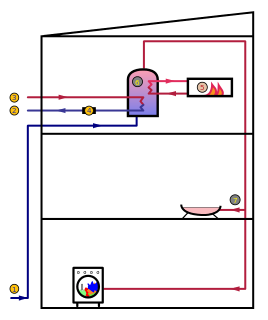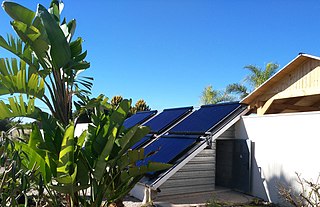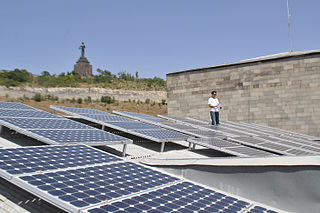Related Research Articles
An autonomous building is a building designed to be operated independently from infrastructural support services such as the electric power grid, gas grid, municipal water systems, sewage treatment systems, storm drains, communication services, and in some cases, public roads.

Solar energy is radiant light and heat from the Sun that is harnessed using a range of ever-evolving technologies such as solar heating, photovoltaics, solar thermal energy, solar architecture, molten salt power plants and artificial photosynthesis.

A heat pump is a device used to warm and sometimes also cool buildings by transferring thermal energy from a cooler space to a warmer space using the refrigeration cycle, being the opposite direction in which heat transfer would take place without the application of external power. Common device types include air source heat pumps, ground source heat pumps, water source heat pumps and exhaust air heat pumps. Heat pumps are also often used in district heating systems.

Solar thermal energy (STE) is a form of energy and a technology for harnessing solar energy to generate thermal energy for use in industry, and in the residential and commercial sectors.

Water heating is a heat transfer process that uses an energy source to heat water above its initial temperature. Typical domestic uses of hot water include cooking, cleaning, bathing, and space heating. In industry, hot water and water heated to steam have many uses.

Solar water heating (SWH) is heating water by sunlight, using a solar thermal collector. A variety of configurations is available at varying cost to provide solutions in different climates and latitudes. SWHs are widely used for residential and some industrial applications.

A low-energy house is characterized by an energy-efficient design and technical features which enable it to provide high living standards and comfort with low energy consumption and carbon emissions. Traditional heating and active cooling systems are absent, or their use is secondary. Low-energy buildings may be viewed as examples of sustainable architecture. Low-energy houses often have active and passive solar building design and components, which reduce the house's energy consumption and minimally impact the resident's lifestyle. Throughout the world, companies and non-profit organizations provide guidelines and issue certifications to guarantee the energy performance of buildings and their processes and materials. Certifications include passive house, BBC - Bâtiment Basse Consommation - Effinergie (France), zero-carbon house (UK), and Minergie (Switzerland).

Passive house is a voluntary standard for energy efficiency in a building, which reduces the building's ecological footprint. It results in ultra-low energy buildings that require little energy for space heating or cooling. A similar standard, MINERGIE-P, is used in Switzerland. The standard is not confined to residential properties; several office buildings, schools, kindergartens and a supermarket have also been constructed to the standard. Passive design is not an attachment or supplement to architectural design, but a design process that integrates with architectural design. Although it is principally applied to new buildings, it has also been used for refurbishments.

Electric heating is a process in which electrical energy is converted to heat energy. Common applications include space heating, cooking, water heating and industrial processes. An electric heater is an electrical device that converts an electric current into heat. The heating element inside every electric heater is an electrical resistor, and works on the principle of Joule heating: an electric current passing through a resistor will convert that electrical energy into heat energy. Most modern electric heating devices use nichrome wire as the active element; the heating element, depicted on the right, uses nichrome wire supported by ceramic insulators.
Renewable heat is an application of renewable energy and it refers to the renewable generation of heat, rather than electrical power. Renewable heat technologies include renewable biofuels, solar heating, geothermal heating, heat pumps and heat exchangers to recover lost heat. Significant attention is also applied to insulation.

Underfloor heating and cooling is a form of central heating and cooling that achieves indoor climate control for thermal comfort using hydronic or electrical heating elements embedded in a floor. Heating is achieved by conduction, radiation and convection. Use of underfloor heating dates back to the Neoglacial and Neolithic periods.

A ground source heat pump is type heating/cooling system for buildings that uses a heat pump to transfer heat to or from the ground, taking advantage of the relatively seasonal constancy of temperatures of the earth through the seasons. Ground source heat pumps (GSHPs) – or geothermal heat pump (GHP) as they are commonly terms in North America – are among the most energy-efficient technologies for providing HVAC and water heating using far less energy that can be achieved by burning a fuel in a boiler/furnace) or by use of resistive electric heaters.

A solar combisystem provides both solar space heating and cooling as well as hot water from a common array of solar thermal collectors, usually backed up by an auxiliary non-solar heat source.

According to preliminary data from the US Energy Information Administration, renewable energy accounted for about 11% of total primary energy consumption and about 17% of the domestically produced electricity in the United States in 2018. Hydroelectric power is currently the largest producer of renewable electricity in the country, generating around 6.5% of the nation's total electricity in 2016 as well as 45.71% of the total renewable electricity generation. The United States is the fourth largest producer of hydroelectricity in the world after China, Canada and Brazil.
Miscellaneous electric loads (MELs) in buildings are electric loads resulting from electronic devices not responsible for space heating, cooling, water heating, or lighting. MELs are produced by hard-wired and “plug-in” electrical devices, including home entertainment centers, kitchen electronics such as microwaves and toaster ovens, bath items such as hair dryers and electric hot tubs, and others such as security systems and ceiling fans. MELs are gaining greater importance as home electronics become more sophisticated and more widespread, and miscellaneous electric use is expected to rise.

Solar hot water is water heated using only energy from the Sun. Solar energy heats up large panels called thermal collectors commonly known as solar panels. The energy is transferred through a fluid to a reservoir tank for storage and subsequent use. It is then used to heat water for commercial or domestic use and also as an energy input for heating and cooling devices and for industrial 'process heat' applications. In domestic solar hot water applications, the thermal collectors can either be coupled together with the hot water storage tank on a rooftop, or separated from the storage tank, in a "split system" configuration.

The use of solar energy began in Israel in the 1950s with the development by Levi Yissar of a solar water heater to address the energy shortages that plagued the new country. By 1967 around 5% of water of households was solar heated and 50,000 solar heaters had been sold. With the 1970s oil crisis, Harry Zvi Tabor developed the prototype of the solar water heater now used in over 90% of Israeli homes. There are over 1.3 million solar water heaters installed as a result of mandatory solar water heating regulations.
Vanir Energy is a renewable energy company located in Fletcher, North Carolina. Vanir Energy, in partnership with EnerWorks, completed in February 2009 what was then described as the world's largest solar heating and cooling installation. This system, installed in the 900000 square-foot Fletcher Business Park, consisted of 640 rooftop solar thermal collectors and two adsorption chillers with a cooling capacity of 300 tons.

A storage water heater, or a hot water system (HWS), is a domestic water heating appliance that uses a hot water storage tank to maximize water heating capacity and provide instantaneous delivery of hot water. Conventional storage water heaters use a variety of fuels, including natural gas, propane, fuel oil, and electricity. Less conventional water heating technologies, such as heat pump water heaters and solar water heaters, can also be categorized as storage water heaters.

Solar energy is widely available in Armenia due to its geographical position and is considered a developing industry.
References
- 1 2 EnerWorks Appliances First ENERGY STAR Qualified Solar Water Heaters
- ↑ "EnerWorks Supplies Largest Solar Heating And Cooling Installation". Archived from the original on 2012-02-13. Retrieved 2009-02-04.
- ↑ Lorinc, John (3 March 2009). "Experiments in District Heating". The New York Times. Retrieved 17 June 2021.